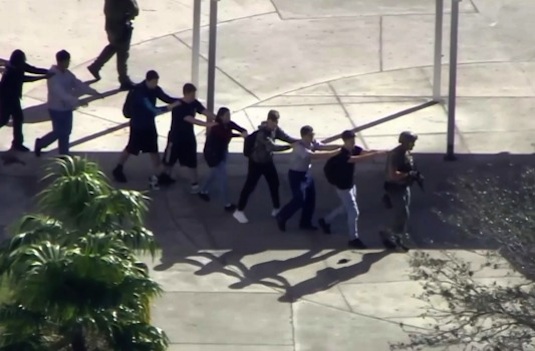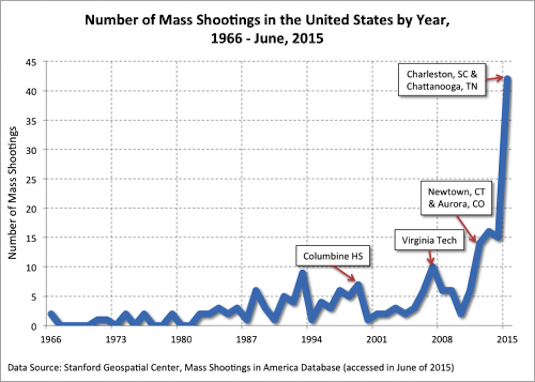
Compounding the sadness of Wednesday's shooting at the Marjory Stoneman Douglas High School in Parkland, Florida is the banality of it all. This sort of crime is now committed with such regularity that no one is surprised when it happens. Almost without knowing any specifics of the case the profile of the shooter can be surmised, and it is as regular as clockwork that the gun lobby and their paid for coterie of Capitol Hill legislators will wring their hands and say it is too early to talk about gun control. If social relations are probabilistic, how an American mass shooting unfolds is now the closest we have to an iron law.
Can sociology offer any further insights? Yes, but the scholarship is relatively slight. Some have looked at mitigation efforts, and conclude they have limited prospects in reducing the number of incidents. America being America, there are even academic efforts aimed at talking down gun control, going so far as to suggest school shootings make the worst possible case for curbing firearms. While it is true if people really want a gun there are ways and means of getting one, apparently gun control measures, i.e. reducing the supply would have little effect - quite why is never explained. There are investigations of contagion, i.e. the media trope that one attack increases the probability of further attacks immediately afterwards, and the argument there is a contagion effect when it comes to school shootings. And others looking at how the violence of a mass shooting is culturally deployed to designate the mentally ill as a violent threat. And, you might suggest, how labelling shooters this way handily pathologises mass murder and heads off serious reflection on the relations that makes mass murder depressingly regular.
On the regularity of US mass shootings (defined as three or more victims in a spree), according to Tristan Bridges and Tara Leigh Tober the frequency looks like this:

In their overview of their chapter in Focus on Social Problems, they suggest the problem is not a matter of drawing a simple line between toxic masculinities and guns. For one, the social conditions in 2015 (when this research was produced) were little different from five years earlier and yet the number of shootings rocketed. Nevertheless they are interested in exploring why it is nearly always men who commit these crimes, and why men elsewhere do not. On the one hand, what they call the social psychological explanation suggests men are likely to use violence if they are prevented from asserting their masculinity in other ways. Secondly, there is the national-specific culture of United States masculinity. This is a gender identity, at least in its hegemonic forms, that finds its privilege as the dominant mode of being a man under threat. Changing gender relations, increasing acceptance of alternative masculinities, the movement toward racial and sexual equality, the levelling of the competition for jobs, and so on all underpin a masculine anomie that can, under certain circumstances, feed into the violent explosions characteristic of the first explanation.
Yet we're no closer to the American specificity of the problem. True, the US is the home of redemptive violence. Shoot first, ask questions later sums its cultural logics up better than twee mom-and-apple-pie homilies. Yet this, like pretty much everything else, is exported. American masculinities are consumed and incorporated into masculine habits and styles all over the world without, at least in the West, anywhere near the same number of murderous outbursts. A different approach is adopted by Joel Cappellan in his PhD dissertation, submitted and examined in September 2016. This is the first properly full-length sociological study of the topic. As Cappellan notes, existing social science literature tends to look at individual risk factors instead of identifying it as a social problem that brings social forces into play. That isn't an invitation to crude sociological determinism, that shooters are helpless puppets of the forces animating them. The relation between context and agency is always complex, but never so rarefied that individual responsibility disappears. Nevertheless, there is social patterning, the shooters mostly share similar biographical characteristics and, yes, they tend to be men.
Cappellan advances two hypotheses: that low rates of social integration and social cohesion make populations more vulnerable to these sorts of attacks, and that media reportage boosts incidence and distribution of them. A review of cases 1970-2014 showed the hypotheses turned out not to be the case, in fact the opposite was true. Mass shootings are more likely in rural states with stable marriage rates and, interestingly, steady socio-economic status - profiles, Cappellan remarks, that bear more similarity to suicide rates than "normal" homicide.
This requires further work, of course. But really it shouldn't be that surprising. Marjory Stoneman Douglas is a middle American school. Sandy Hook is a middle American school. Columbine is a middle American school. What they appear to have in common is their situation in communities where social cohesion wasn't particularly frayed. Rather, the shooters were effectively outcasts within their communities. Nicholas Cruz, the latest name added to the roll call of infamy, was the stereotypical loner excluded from school. Adam Lanza hadn't left the house for three months prior to his attack, for which he planned methodically for. Eric Harris and Dylan Klebold were well known in their school for being weird, and were shunned and occasionally bullied. It seems the relationship between cohesion and exclusion is worth exploring in more depth, that from their standpoint the appearance of comfortable normalcy within sight but not within reach is a social tension that may (or may not) be a significant contribution to the making of a mass shooter.
And yet there is still the one thing missing: exceptionalism. As these relationships and tensions can be found in other Western societies, and given the export of American masculinities and its celebration of militarism and violence, the question remains unanswered and an explanation of why America missing. Gun control has to be a central component of any strategy that wants to stamp these massacres out. It follows that making them harder to get hold of makes a school shooting more difficult to do, but a lot more work has to be done to tease out the specifically American dimensions of the problem. Doing so is no idle exercise - it is research that, in the long run, can save hundreds of lives and spare further agonies.
5 comments:
Much of the reasearch above bears a very close resemblance to Durkeimian notions of the relationship between the intensity of community integration and levels of social pathology (e.g. rates of suicide/divorce/lawlessness etc). For Durkheim, over-integration is as bad as under-integration I.e. small-towns in middle America are often isolated and over-integrated. By necessity, such towns 'need' to create 'outsiders' (deviants) in order to flex its collective moral muscle and thereby re-establish its idealised sets of norms and values. When deviance turns into 'outrage', new moral boundaries are created (either tighter or more relaxed). ............. Just saying........
Interesting article Phil, but I'm surprised you didn't make more of the graph. Gun control hasn't dramatically lessened since 2008, but economic prospects for anyone but the super-rich have greatly worsened.
European liberals witter on about gun control as if it's a no-brainer. But as you point out, the Swiss are armed to the teeth but they don't have this problem. Likewise the Israelis, which is even more interesting as they're surely a very aggressive culture. Maybe it's because all of their aggression is directed outwards?
Being an academic you will presumably have "Guns and Violence: The English Experience" in your Uni library. You should read it, it's a very readable evidenced academic defence of the right to bear arms.
One more thing. Reducing availability of guns might reduce mass SHOOTINGS, but it wouldn't necessarily reduce mass KILLINGS. Surely the Islamists have have that clear in recent years, with their massacres using knives and vehicles as weapons?
I wonder if the American market in guns has changed over the years with military style automatic weapons on sale to the general public when in previous decade the gun shops basically stocked hunting rifles and revolvers.
Frustrated masculinity must surely be rife in many Muslim countries, which on the one hand suffer from endemic poverty and unemployment, and on the other hand are dominated by a religion which explicitly endorses the breadwinner ethic.
Surely the fact that these countries do not have a US-style epidemic of (non-terrorist) mass killings suggests that toxic masculinity isn't the only problem in the US? Or is it a collectivism versus individualism thing, where the same kind of men who join terrorist groups in the Middle East commit mass murder on an individual basis (and without attempting to justify it in political or religious terms) in the United States?
I couldn't give a shit if Americans want to kill each other, I get more concerned when they get the urge to kill everyone else!
But anyway.
Gun control has to be part of it, if the Las Vegas shooter had been born in England he would have kicked the cat, woke up the next day and said sorry to the cat. But in the USA he can get a gun, in a culture of guns, with a history of the wild West and instead of kicking the cat to vent his frustrations he shot loads of people.
The reason gun control is opposed by the NRA is obvious, more gun control means less sales of guns which means less revenue. Now that is all American thinking!
Post a Comment